Title
Buzbee, Bill SIAM oral history
Catalog Number
102746784
Type
Document
Description
Bill Buzbee discusses his career as a mathematical specialist within Los Alamos and the National Center for Atmospheric Research (NCAR) and his involvement in the field of mathematical software. Buzbee served in the Air Force before gaining undergraduate and masters’ degree in mathematics and numerical analysis from the University of Texas at Austin where he studied with David Young and Bob Gregory. After graduation in 1962, he went to work at Los Alamos where he remained until 1987 aside from a brief stint at Esso in 1967-8 working on three-dimensional reservoir simulation. At Los Alamos he worked first on weapons simulations, but soon joined the central computing group, where he worked on implementing algorithms from Jim Wilkinson’s Algebraic Eigenvalue Problem. During this period he came into contact with the emerging community of people interested in mathematical software, including Cleve Moler, Jim Pool, Gene Golub and Jack Dongarra. He obtained his PhD from the University of New Mexico in 1972, after which he took over the management of a group within Los Alamos working on mathematical software and programming services. In 1974, Buzbee became a member of the Common Math Library Subcommittee of a new inter-laboratory program called SLATEC, devoted to encouraging technical collaboration between the computing departments of atomic weapons sites. This program eventually produced the SLATEC Library, a merged and consolidated collection of mathematical routines. During the early 1980s, Buzbee rose into more senior management positions at Los Alamos and played an important role in advising the federal government on the new field of supercomputing. He also emerged as an expert in the new field of parallel computing. In 1987, Buzbee moved to the National Center for Atmospheric Research (NCAR) where he headed its Scientific Computing Division until 1998. While the division thrived under Buzbee’s leadership, in 1996 he found himself in the center of a political storm following a decision to procure the Japanese-built NEC SX-4 supercomputer for climate simulation, rather than an American model. Buzbee discusses the issues involved and his experiences at this time. Buzbee retired not long after the procurement was halted following actions by the U.S. Department of Commerce to create trade barriers against the importation of the Japanese machine. He has remained active as a consultant to several organizations, including the Arctic Regional Supercomputer Center.
Date
2005-08-08; 2005-08-09
Contributor
|
Buzbee, Bill, Interviewee
|
|
Haigh, Thomas, Interviewer
|
Publisher
SIAM and U.S. Department of Energy
Place of Publication
Westminster, Colorado, United States
Extent
70 p.
Format
PDF
Copyright Holder
Computer History Museum
Category
Transcription
Subject
National Center for Atmospheric Research (NCAR); Los Alamos National Laboratory; Mathematical software; Reservoir simulation; SLATEC Common Mathematical Library; EISPACK; LINPACK (Software library); supercomputing; Climate simulation
Collection Title
Society for Industrial and Applied Mathematics (SIAM) oral history collection
Credit
Gift of SIAM and the US Department of Energy


